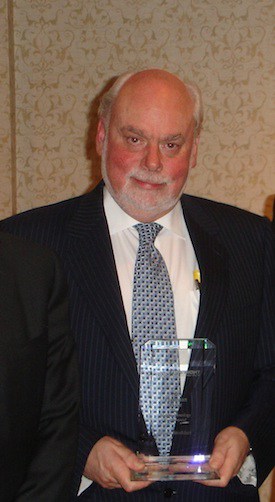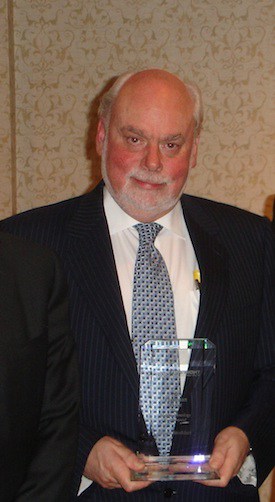
The 2016 Nobel Prize in Chemistry was awarded to three scientists who “developed the world’s smallest machines”. From the Royal Swedish Academy of Sciences “Press Release: The Nobel Prize in Chemistry 2016“:
The Royal Swedish Academy of Sciences has decided to award the Nobel Prize in Chemistry 2016 to
Jean-Pierre Sauvage, University of Strasbourg, France
Sir J. Fraser Stoddart, Northwestern University, Evanston, IL, USA, and
Bernard L. Feringa, University of Groningen, the Netherlands
“for the design and synthesis of molecular machines” …A tiny lift, artificial muscles and minuscule motors. The Nobel Prize in Chemistry 2016 is awarded to Jean-Pierre Sauvage, Sir J. Fraser Stoddart and Bernard L. Feringa for their design and production of molecular machines. They have developed molecules with controllable movements, which can perform a task when energy is added.
The development of computing demonstrates how the miniaturisation of technology can lead to a revolution. The 2016 Nobel Laureates in Chemistry have miniaturised machines and taken chemistry to a new dimension.
The first step towards a molecular machine was taken by Jean-Pierre Sauvage in 1983, when he succeeded in linking two ring-shaped molecules together to form a chain, called a catenane. Normally, molecules are joined by strong covalent bonds in which the atoms share electrons, but in the chain they were instead linked by a freer mechanical bond. For a machine to be able to perform a task it must consist of parts that can move relative to each other. The two interlocked rings fulfilled exactly this requirement.
The second step was taken by Fraser Stoddart in 1991, when he developed a rotaxane. He threaded a molecular ring onto a thin molecular axle and demonstrated that the ring was able to move along the axle. Among his developments based on rotaxanes are a molecular lift, a molecular muscle and a molecule-based computer chip.
Bernard Feringa was the first person to develop a molecular motor; in 1999 he got a molecular rotor blade to spin continually in the same direction. Using molecular motors, he has rotated a glass cylinder that is 10,000 times bigger than the motor and also designed a nanocar.
2016’s Nobel Laureates in Chemistry have taken molecular systems out of equilibrium’s stalemate and into energy-filled states in which their movements can be controlled. In terms of development, the molecular motor is at the same stage as the electric motor was in the 1830s, when scientists displayed various spinning cranks and wheels, unaware that they would lead to washing machines, fans and food processors. Molecular machines will most likely be used in the development of things such as new materials, sensors and energy storage systems.
The award of this chemistry Nobel demonstrates that the scientific establishment is moving toward the vision of constructing atomically-precise products through the use of systems of molecular machines. This vision was first elucidated by Nobel laureate physicist Richard Feynman, who proposed in 1959 that “The problems of chemistry and biology can be greatly helped if our ability to see what we are doing, and to do things on an atomic level, is ultimately developed — a development which I think cannot be avoided.” The Foresight Institute was founded in 1986 on a vision of the emerging field of nanotechnology in which current capabilities in several areas of science and technology lead eventually to fabrication of complex products with atom-by-atom control of the manufacturing process. This vision was inspired by analogy with the biological molecular machines that form the basis of life, with the added insight that biology points “to the development of general capabilities for molecular manipulation”, initially termed molecular engineering.
Although Foresight’s initial focus on molecular engineering paths to molecular nanotechnology was on protein engineering, it was soon (1987) realized that relatively simple organic molecules could perform functions like those of natural proteins. A few years after he began working on rotaxanes—work recognized by the Nobel this year—J. Fraser Stoddart, then at the University of Birmingham, spoke in 1995 at the Fourth Foresight Conference on Molecular Nanotechnology on “The Art and Science of Self-Assembling Molecular Machines“. Eight years later Stoddart, then at the California NanoSystems Institute/Department of Chemistry and Biochemistry, University of California, Los Angeles, was a keynote speaker at the 11th Foresight Conference on Molecular Nanotechnology, speaking on “Meccano on the NanoScale: A Blueprint for Making Some of the World’s Tiniest Machines“.
In 2007, Sir Fraser, by then at Northwestern University, was recognized by the award of Foresight’s 2007 Feynman Prize in Nanotechnology in the Experiment category for pioneering “the synthesis and assembly of unique active molecular machines for manufacturing into practical nanoscale devices. His many accomplishments in synthetic chemistry have produced functional molecular machines, in particular a ‘molecular muscle’ for the purposes of amplifying and harnessing molecular mechanical motions, that may ultimately lead to the construction of atomically-precise products through the use of molecular machine systems.” In accepting the award, Sir Fraser commented that the Feynman awards that year represented a unique, scientific “father and son” celebration since the winner in the Theory category was David A. Leigh, then of the University of Edinburgh, for “the design and synthesis of artificial molecular motors and machines from first principles” … “focusing on the construction of molecular machine systems that function in the realm of Brownian motion”. Prof. Leigh had obtained his PhD in 1987 under Prof. Stoddart’s supervision at the University of Sheffield.
At Foresight Institute’s 25th Anniversary Reunion Conference in 2011 Sir Fraser spoke on “Integrating Molecular Switches and Machines with the Everyday World”. He co-chaired the 2013 Foresight Conference “Illuminating Atomic Precision“, chaired the session on “Molecular Machines and Non-Equilibrium Processes”, and lectured on “Autonomous Artificial Molecular Transport”. His most recent work that was featured in this blog includes addressable molecular machines arranged in a porous crystal (September, 2015) and an artificial molecular pump (May 2015). The graduate student who was first author of the molecular pump paper (Chuyang Cheng, now a postdoctoral researcher in Stoddart’s group) won Foresight’s 2015 Distinguished Student Award, the second of Prof. Stoddart’s graduate students to win this award. Finally, we noted in December of 2011 that Prof. Stoddart co-authored a review of molecular machines that addressed whether artificial molecular machines could deliver the performance that visionaries expect. His senior co-authors of that review subsequently themselves became Foresight Feynman prize winners: R. Dean Astumian (2011, Theory category), and Bartosz A. Grzybowski (2016, Theory category).
The discovery by Jean-Pierre Sauvage in 1983 of the mechanical bond, which made possible the avalanche of work on molecular machines, occurred several years before Foresight came into existence; however, in June of 2011 we pointed to a major book co-edited by Prof. Sauvage on supramolecular chemistry and molecular machines, published that year, that collected papers and discussions from the 21st Solvay Conference on Chemistry (held in 2007). The third Nobel laureate, Prof. Bernard Feringa, spoke at Foresight’s 2013 Conference on “Molecular Rotary Motors“. A year ago in this blog we noted his demonstration of “One-directional rotation in a new artificial molecular motor“, and a post in October 2012 pointed to a review that included a description of a molecular car developed by Feringa. A post here from October 2006 pointed to an article from Prof. Feringa on “Making molecular machines work”. One of the earliest posts on this blog pointed to commentary by Feringa in Nature “In control of molecular motion”, which included commentary on Prof. Sauvage’s work on molecular muscles implemented by contraction and stretching of a linear rotaxane dimer.
We are not the only ones to see the 2016 Chemistry Nobel as a turning point for nanotechnology. CBC news blogger Bob McDonald compares this award to Michael Faraday’s discovery of electromagnetic induction “BLOG: Nanotechnology on the cusp: Bob McDonald“:
The Nobel Prize in Chemistry awarded this week for developments in nanotechnology heralds a new era in science, akin to the discovery of electromagnetic induction 185 years ago. And like electricity, nanotechnology could influence the world in dramatic ways, not even imaginable today. …
There have been revolutions in technology since people discovered that metals made better tools than stone, or that computer chips could calculate better than mechanical machines. These are exciting times to be alive at the beginning of what could be another powerful game changer in human achievement.
Another appreciation of the importance of molecular machines recognized by this Nobel comes from a post on The Week by Ryan Cooper (hat tip to Gayle Pergamit) “Why organic chemistry is awesome“:
… the recently awarded Nobel Prize in Chemistry affords a great opportunity to appreciate the subtleties of organic chemistry. It’s not about sweeping theories of reality or evolution, but instead about building up, through years of painstaking and elaborate work, new and astonishing ways to manipulate atoms and molecules that could change how we live our lives. …
It’s not entirely clear yet what you could do with this stuff. But as Richard Feynman pointed out in 1959, the eventual end goal is to be able to build things one atom at a time. This would be tremendously powerful. We could create new objects with incredible precision, which means far less waste. “Technology has never had this kind of precise control; all of our technologies today are bulk technologies,” explains The Foresight Institute. “We take a lump of something and add or remove pieces until we’re left with whatever object we were trying to create.” The rest gets tossed aside. No more with molecular manufacturing.
And imagine what we could do by sending tiny machines into hard-to-reach places. For example, the blood stream:
Theorists envision creating machines that will be able to travel through the circulatory system, cleaning the arteries as they go; sending out troops to track down and destroy cancer cells and tumors; or repairing injured tissue at the site of the wound, even to the point of replacing missing limbs or damaged organs. [The Foresight Institute]
There will surely be more applications to come, and with them, perhaps more well-deserved Nobel Prizes. And maybe chemistry will get its own household name, after all. But in the mean time, let us celebrate the marvels of this field and all it has to offer our future.
Foresight looks forward to covering how molecular machines and other technologies will eventually bring general purpose, high-throughput atomically precise manufacturing, and how this breakthrough will synergize with breakthroughs in biotechnology and medicine, artificial intelligence, and other rapidly developing transformative technologies to create a flourishing and and abundant future for humanity.
—James Lewis, PhD
Discuss these news stories on Foresight’s Facebook page or on our Facebook group.
